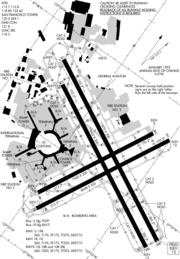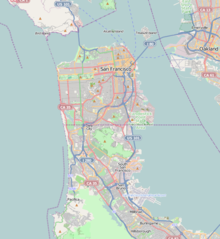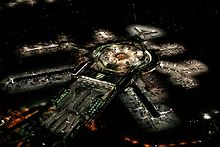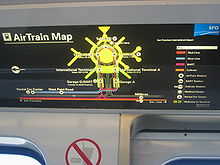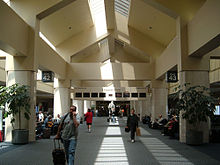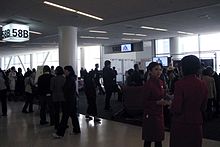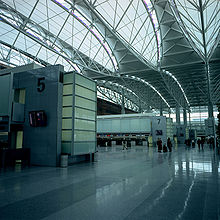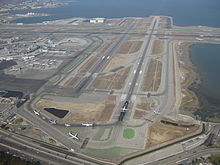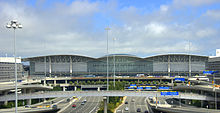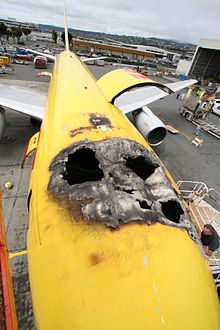- San Francisco International Airport
-
This article is about the airport. For the BART Station servicing the airport, see San Francisco International Airport (BART station). For the television series, see San Francisco International Airport (TV series).
San Francisco International Airport 
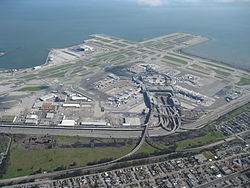
IATA: SFO – ICAO: KSFO – FAA LID: SFO Summary Airport type Public Owner San Francisco Airport Commission Serves San Francisco Location San Mateo County (unincorporated) Hub for Elevation AMSL 13 ft / 4 m Coordinates 37°37′08″N 122°22′30″W / 37.61889°N 122.375°WCoordinates: 37°37′08″N 122°22′30″W / 37.61889°N 122.375°W Website Maps FAA airport diagram Location within the San Francisco Peninsula Runways Direction Length Surface ft m 10L/28R 11,870 3,618 Asphalt 10R/28L 10,602 3,231 Asphalt 1R/19L 8,648 2,636 Asphalt 1L/19R 7,500 2,286 Asphalt Statistics (2010) Aircraft operations 387,248 Passengers 39,391,234 [1] and FAA[2] San Francisco International Airport (IATA: SFO, ICAO: KSFO, FAA LID: SFO) is a major international airport located 13 miles (21 km) south of downtown San Francisco, California, United States, near the cities of Millbrae and San Bruno in unincorporated San Mateo County.[3] It is often referred to as SFO. The airport has flights to points throughout North America and is a major gateway to Europe and Asia.
It is the largest airport in the San Francisco Bay Area and the second busiest airport in California after Los Angeles International Airport. In 2009 San Francisco International Airport was the tenth busiest in the United States[4] and the twentieth largest airport in the world,[5] by passenger count. It is a major hub of United Airlines. Following United's merger with Continental Airlines, the airport will be the sixth largest hub for United. It is Virgin America's principal base of operations.[6] It is the sole maintenance hub of United Airlines. SFO has numerous passenger amenities, including a range of food and drink establishments, shopping, baggage storage, public showers, a medical clinic, and assistance for lost or stranded travelers and military personnel. It has the Louis A. Turpen Aviation Museum, the San Francisco Airport Commission Aviation Library, and permanent and temporary art exhibitions in several places in the terminals. Free Wi-Fi is available to the public in most of the terminal area.[7]
Although located in San Mateo County, SFO is under the jurisdiction of the City and County of San Francisco. Because of its unique status in California as a consolidated city-county, San Francisco's local government exercises jurisdiction over property that would otherwise be located outside of its corporation limit. For example, SFO Enterprises Inc., was created by the San Francisco Airport Commission to oversee its business purchases and operations of ventures such as owning Honduran airports.[8] [9] [10][11]
Contents
History
The airport opened on May 7, 1927[12] on 150 acres (61 ha) of cow pasture. The land was leased from prominent local landowner Ogden L. Mills, (who in turn had leased it from his grandfather Darius O. Mills) and was named Mills Field Municipal Airport. It remained Mills Field until 1931, when it was renamed San Francisco Municipal Airport. "Municipal" was replaced by "International" in 1955.
United Airlines used the Mills Field airport as well as the Oakland Municipal Airport starting in the 1930s.[13] The March 1939 OAG shows 12 airline departures on weekdays— eleven United and one TWA. The aerial view circa 1940 looks west along the runway that is now 28R; the seaplane harbor at right is still recognizable north of the airport. Earlier aerial looking NW 1943 vertical aerial (enlargeable)After the war United Airlines used the Pan Am terminal 37°38′05″N 122°23′24″W / 37.6347°N 122.39°W for its DC-6 flights to Hawaii starting in 1947. SFO is now one of five United Airlines hubs and their largest maintenance facility.
In 1954 the airport's Central Passenger Terminal opened.[14] (It was heavily rebuilt into the international terminal circa 1984, then re-rebuilt into present Terminal 2.) The April 1957 OAG shows 71 scheduled weekday departures on United (plus ten flights a week to Honolulu), 22 on Western, 19 on Southwest, 12 on TWA, 7 American and 3 PSA. Also, 21 departures a week on Pan American, 5 on Japan Air and 5 on QANTAS. Jet service to SFO began in March 1959, with TWA 707-131s; United built a large maintenance facility at San Francisco for its new Douglas DC-8s. In July 1959 the first jetway bridge was installed, one of the first in the United States.
Operations, expansion, retreat, and recovery
In 1989 an airport master plan and Environmental Impact Report were prepared to guide development over the next two decades.[15][verification needed] During the economic boom of the 1990s and the dot-com boom SFO became the sixth busiest international airport in the world, but since 2001, when the boom ended, SFO has fallen out of the top twenty.[5]
The airport closed following the Loma Prieta Earthquake on October 17, 1989, reopening the following morning.[16] It suffered some damage to runways.
SFO has expanded continuously through the decades. Most recently, a new $1 billion international terminal opened in December 2000, replacing Terminal 2 as the international terminal.[14] This new terminal contains a world-class aviation library and museum.[17] SFO’s long-running program of cultural exhibits, now called the San Francisco Airport Museums, won unprecedented accreditation by the American Association of Museums in 1999.[18]
A long-planned extension of the Bay Area Rapid Transit system to the airport opened on June 22, 2003, allowing passengers to board trains at the airport's international terminal to San Francisco or points in the East Bay.[19] In 2003, the AirTrain shuttle system opened, conveying passengers between terminals, parking lots, the SFO BART station, and the rental car center on small automatic trains.
SFO experiences significant delays (known as flow control) in adverse weather, when only two of the airport's four runways can be used at a time, due to the lateral separation of only 750 feet (230 m) between centerlines of the parallel pairs of runways. Airport planners have floated proposals to extend the airport's runways further into San Francisco Bay in order to accommodate the large number of arrivals and departures during low-visibility conditions. To expand further into the bay, the airport would be required by law to restore bay land elsewhere in the Bay Area to offset the fill. Such proposals have met resistance from environmental groups, fearing damage to the habitat of animals near the airport, recreational degradation (such as windsurfing) and bay water quality.
Such delays (among other reasons) have caused many airlines, especially low-cost carriers, to shift service to the other Bay Area airports at Oakland and San Jose.
Recently, recovery at SFO has been evident. Spirit Airlines and Qantas began service to SFO in 2006. United Airlines changed service to Seoul from seasonal to year-round and reinstated non-stop service to Taipei's Taiwan Taoyuan International Airport on June 7, 2007.[20] Nonstop service to Taipei was later discontinued in 2008 and is now flown via Narita International Airport near Tokyo. Also, service to Nagoya's Chūbu Centrair International Airport was also discontinued later that year. In addition, SFO has become the base of operations for start-up airline Virgin America. In March 2007, Air China increased the frequency of the Beijing-San Francisco service from 5 times weekly to daily, with plans to increase to two daily. In 2007 JetBlue Airways[21] and Irish airline Aer Lingus began service, while Southwest Airlines returned after pulling out in May 2001 citing high costs and delays.[22] Aer Lingus ended its service to San Francisco from Dublin on 24 October 2009, due to Aer Lingus financial problems. In May 2008, Jet Airways began service from San Francisco to Mumbai's Chhatrapati Shivaji International Airport with a stop at Shanghai Pudong International Airport, but it was later discontinued in January 2009, citing poor load factors. In June 2010, Swiss International Airlines began service from San Francisco to Zurich Airport.
The FAA has warned that the airport's control tower would be unable to withstand a major earthquake and has requested that it be replaced. Construction on the new 216 ft (66 m), US$81 million tower, which will be located between terminals 1 and 2, is planned to begin within September 2012 with completion by 2014.[23]
SFO was one of several US airports which operated the Registered Traveler program from April 2007 until funding ended in June 2009, which had allowed travelers to pass through security checkpoints quickly.[24][25] Baggage and passenger screening is operated by Covenant Aviation Security, a TSA contractor, nicknamed "Team SFO." SFO was the first airport in the United States to integrate in-line baggage screening into its baggage-handling system and has been a model for other airports in the post-9/11 era.[18]
On October 4, 2007 an Airbus A380 jumbo jet made its first visit and test flight to the airport.[26]
On July 14, 2008 SFO was voted Best International Airport in North America for 2008 in the World Airports Survey by Skytrax.[27] The following year on June 9, Skytrax announced SFO as the second Best International Airport in North America in the 2009 World Airports Survey, losing to Dallas/Fort Worth International Airport.[28]
During the summer of 2011, Lufthansa & Air France were the only carriers using the Airbus A380 at SFO, albeit seasonally. As of Autumn 2011, only Lufthansa has indicated that it will bring back the A380 for the next summer season.
Aircraft noise abatement
SFO was one of the first airports to implement a Fly Quiet Program which grades individual air carriers on their performance on noise abatement procedures while flying in and out of SFO. The Jon C. Long Fly Quiet Program[dead link] was started by the Aircraft Noise Abatement Office to encourage individual airlines to operate as quietly as possible at SFO. The program promotes a participatory approach in complying with the noise abatement procedures.
SFO was also one of the first U.S. airports to conduct a residential sound abatement retrofitting program. Established by the FAA in the early 1980s, this program evaluated the cost effectiveness of reducing interior sound levels for homes in the vicinity of the airport, or more particularly homes within the 65 CNEL noise contour surface. The program made use of a noise computer model to predict improvement in specific residential interiors for a variety of different noise control strategies. This pilot program was conducted for a neighborhood in the city of South San Francisco, and success was achieved in all of the homes analyzed. The construction costs turned out to be modest, and the post-construction interior sound level tests confirmed the model predictions for noise abatement. To date over $153 million has been spent to insulate in excess of 15,000 homes throughout the neighboring cities of Daly City, Pacifica, San Bruno, and South San Francisco.[29]
Terminals
The airport has four terminals (1, 2, 3, and International) and seven concourses (A through G) arranged in a ring. Terminal 1 (Boarding Areas B and C), Terminal 2 (Boarding Area D), and Terminal 3 (Boarding Areas E and F) handle domestic flights (including precleared flights from Canada). The International Terminal (Boarding Areas A and G) handle international flights and some domestic flights.
Terminal 1
Formerly known as the South Terminal, Terminal 1 has Boarding Area B (including gates 20–31, 32–32B, 33–36) and Boarding Area C (gates 40–48). A third boarding area, Rotunda A, was demolished in 2007. The first version of the terminal opened in 1963; Rotunda A opened in 1974.
Terminal 2
Terminal 2, formerly known as the Central Terminal, opened in 1954 as the main airport terminal. After a drastic rebuilding it replaced Rotunda A as SFO's international terminal in 1983[30] and was closed for indefinite renovation when the current international terminal opened in 2000. Its only concourse is Boarding Area D (gates 50, 51A, 51B, 52, 53, 54A, 54B, 55, 56A, 56B, 57, 58A, 58B, 59). The control tower and most operations offices were (and still are) located on the upper levels, and the departure and arrival areas served as walkways between Terminal 1 and Terminal 3.
On May 12, 2008, a US$383 million renovation project was announced that included a new control tower, the use of green materials, and a seismic retrofit.[31] The newly renovated terminal features permanent art installations from Janet Echelman, Kendall Buster, Norie Sato, Charles Sowers, and Walter Kitundu.[32] Terminal 2 set accolades by being the first U.S. airport to achieve LEED Gold status.[33] The terminal reopened on April 14, 2011, with Virgin America and American Airlines sharing the new 14-gate common-use facility.[34][35]
Terminal 3
Formerly known as the North Terminal, Terminal 3 has Boarding Area E (gates 60–60A, 61, 62A–B, 63, 64–64A, 65–65A, 66–66A, 67) and Boarding Area F (gates 68–72, 73–73A, 74–75, 76A–76B, 77A–77B, 78A–78B, 79–86, 87–87A, 88–90). This terminal is now used only by United Airlines and merger partner Continental Airlines.[36] Boarding area F opened in 1978-79 and area E opened a few years later.
International Terminal
SFO's international terminal was designed by Craig W. Hartman of Skidmore, Owings and Merrill and opened in December 2000 to replace International Departures from Terminal 2. It is the largest international terminal in North America, and is the largest building in the world built on base isolators to protect against earthquakes.[37] Following the theme in other SFO terminals, food service focuses on quick service versions of leading Bay Area restaurants. SFO planners attempted to make the airport a destination in and of itself, not just for travelers that are passing through.[38] The international terminal is a common use facility, with all gates and all ticketing areas shared among the international airlines. All international arrivals and departures are handled here (except flights from cities with customs preclearance). The airport BART station is also located in this terminal, at the garage leading to Boarding Area G. The SFO Medical Clinic is located next to the security screening area of Boarding Area A. All the gates in this terminal have two jetway bridges with the exception of gates A2 and A10, which have one. Gates A1, A3, and A11 are capable of accommodating two aircraft. Six gates are specifically designed for the Airbus A380, making SFO one of the first airports in the world with such gates when it was constructed in 2000.[39] For lack of space, the terminal was constructed on top of the airport's main access road at enormous expense, completing the continuous "ring" of terminals. The terminal required its own elaborate set of ramps to connect it with Highway 101. The design and construction of the international terminal is owed to Skidmore, Owings & Merrill, Del Campo & Maru Architects, Michael Willis Associates (main terminal building), Hellmuth, Obata and Kassabaum (Boarding Area G) & Gerson/Overstreet Architects (Boarding Area A).[37] The contracts were awarded after an architectural design competition. If all gates in an airlines' designated international boarding area are full, passengers will board or deplane from the opposite international boarding area.
All SkyTeam, Oneworld and non-aligned international carriers aside from Emirates and EVA Air operate from Boarding Area A (gates A1–A10, A11–A11A, A12). Asiana and Air Canada are the only Star Alliance carriers that uses Boarding Area A.
All international Star Alliance members aside from Air Canada (some flights) and Asiana use Boarding Area G (gates G91, G92–G92A, G93–G98, G99–G99A, G100, G101–G101A, G102), as well as non-aligned EVA Air and Emirates. In 2010, some United domestic flights now utilize the Area G, as shown in below.
In addition to international flights, domestic flights from the airlines JetBlue Airways and Sun Country Airlines also operate from the International Terminal, using boarding area A.
Airlines and destinations
- Note: All international arrivals (except flights from customs preclearance) are handled at the International Terminal (Boarding Areas A and G).
Airlines Destinations Boarding Area Aeroméxico Guadalajara, Mexico City A Air Berlin Seasonal: Düsseldorf A Air Canada Toronto-Pearson, Vancouver
Seasonal: Montréal-TrudeauA, G Air China Beijing-Capital G Air France Paris-Charles de Gaulle A Air New Zealand Auckland G AirTran Airways Atlanta, Milwaukee
Seasonal: BaltimoreB Alaska Airlines Palm Springs, Portland (OR), Puerto Vallarta, San José del Cabo, Seattle/Tacoma
Seasonal: AnchorageB Alaska Airlines operated by Horizon Air Portland (OR) B All Nippon Airways Tokyo-Narita G American Airlines Chicago-O'Hare, Dallas/Fort Worth, Los Angeles, Miami, New York-JFK D Asiana Airlines Seoul-Incheon A British Airways London-Heathrow A Cathay Pacific Hong Kong A China Airlines Taipei-Taoyuan A Continental Airlines Boston, Chicago-O'Hare, Cleveland, Denver, Guadalajara, Hilo, Honolulu, Houston-Intercontinental, Las Vegas, Newark
Seasonal: AnchorageF[40] Delta Air Lines Atlanta, Cincinnati/Northern Kentucky, Detroit, Honolulu, Minneapolis/St. Paul, New York-JFK, Salt Lake City C Delta Air Lines Tokyo-Narita A Delta Connection operated by SkyWest Airlines Los Angeles, Salt Lake City C Emirates Dubai G EVA Air Taipei-Taoyuan G Frontier Airlines Denver, Kansas City C Hawaiian Airlines Honolulu A Japan Airlines Tokyo-Haneda A JetBlue Airways Austin, Boston, Fort Lauderdale, Long Beach, New York-JFK A KLM Amsterdam A Korean Air Seoul-Incheon A LAN Peru Lima A Lufthansa Frankfurt, Munich G Philippine Airlines Manila A Singapore Airlines Hong Kong, Seoul-Incheon, Singapore G Southwest Airlines Chicago-Midway, Denver, Las Vegas, Los Angeles, Orange County, Phoenix, San Diego B Sun Country Airlines Minneapolis/St. Paul A Swiss International Air Lines Zürich G TACA Airlines San Salvador A United Airlines Baltimore, Boston, Chicago-O'Hare, Dallas/Fort Worth, Denver, Honolulu, Houston-Intercontinental, Kahului, Kona, Las Vegas, Lihue, Los Angeles, Minneapolis/St. Paul, New Orleans, New York-JFK, Newark, Orange County, Orlando, Philadelphia, Phoenix, Pittsburgh, Portland (OR), Reno/Tahoe, St. Louis, Salt Lake City, San Diego, Seattle/Tacoma, Toronto-Pearson, Vancouver, Washington-Dulles F, G United Airlines Beijing-Capital, Frankfurt, Hong Kong, London-Heathrow, Mexico City, Osaka-Kansai, Seoul-Incheon, Shanghai-Pudong, Sydney, Tokyo-Narita
Seasonal: Cancún, Puerto Vallarta, San José del CaboG United Express operated by SkyWest Airlines Albuquerque, Austin, Bakersfield, Boise, Burbank, Calgary, Chico, Colorado Springs, Crescent City, Dallas/Fort Worth, Edmonton, Eugene, Eureka/Arcata, Fresno, Idaho Falls, Kansas City, Klamath Falls, Las Vegas, Medford, Modesto, Monterey, North Bend, Oklahoma City, Ontario, Orange County, Palm Springs, Pasco, Phoenix, Portland (OR), Redding, Redmond/Bend, Reno/Tahoe, Sacramento, Salt Lake City, San Antonio, San Diego, San Luis Obispo, Santa Barbara, Seattle/Tacoma, Spokane, Tucson, Vancouver, Victoria
Seasonal: Aspen, Bozeman, Mammoth Lakes, MissoulaF US Airways Charlotte, Las Vegas [ends November 29], Philadelphia, Phoenix B US Airways Express operated by Mesa Airlines Las Vegas [ends November 29] B Virgin America Boston, Cancún, Chicago-O'Hare, Dallas/Fort Worth, Fort Lauderdale, Las Vegas, Los Angeles, New York-JFK, Orlando, Puerto Vallarta [begins December 2],[41] San Diego, San José del Cabo, Seattle/Tacoma, Washington-Dulles
Seasonal: Palm Springs [begins December 15][42]D Virgin Atlantic Airways London-Heathrow A WestJet Seasonal: Calgary, Vancouver A XL Airways France Seasonal: Paris-Charles de Gaulle [begins May 26, 2012][43] TBA Top destinations
Busiest International Routes from SFO (October 2009-September 2010) [44] Rank Airport Passengers Carriers 1  London (Heathrow), United Kingdom
London (Heathrow), United Kingdom1,031,000 British Airways, United, Virgin Atlantic 2  Hong Kong
Hong Kong908,000 Cathay Pacific, Singapore, United 3  Tokyo (Narita), Japan
Tokyo (Narita), Japan733,226 All Nippon Airways, Delta, United 4  Seoul (Incheon), South Korea
Seoul (Incheon), South Korea566,987 Asiana Airlines, Korean Air, Singapore Airlines, United 5  Frankfurt, Germany
Frankfurt, Germany541,449 Lufthansa, United 6  Taipei (Taoyuan), Taiwan
Taipei (Taoyuan), Taiwan522,417 China Airlines, EVA Air Busiest Domestic Routes from SFO (August 2010 – July 2011)[45] Rank City Passengers Top Carriers 1  Los Angeles, CA
Los Angeles, CA1,566,000 American, Delta, Southwest, United, Virgin America 2  New York, NY (JFK)
New York, NY (JFK)1,020,000 American, Delta, JetBlue, United, Virgin America 3  Chicago, IL (ORD)
Chicago, IL (ORD)977,000 American, Continental, United, Virgin America 4  Las Vegas, NV
Las Vegas, NV852,000 Continental, Southwest, United, US Airways, Virgin America 5  Denver, CO
Denver, CO779,000 Frontier, Southwest, United 6  Seattle, WA
Seattle, WA713,000 Alaska, United, Virgin America 7  San Diego, CA
San Diego, CA702,000 Southwest, United, Virgin America 8  Washington, DC (IAD)
Washington, DC (IAD)593,000 United, Virgin America 9  Dallas/Fort Worth, TX
Dallas/Fort Worth, TX589,000 American, United, Virgin America 10  Atlanta, GA
Atlanta, GA565,000 AirTran, Delta Ground transportation
AirTrain
AirTrain is the airport's people-mover system. Fully automated and free of charge, it connects all four terminals, the two international terminal garages, the BART station, and the airport's Rental Car Center.[46]
Rail
BART
The San Francisco International Airport (SFO) BART station, located in Parking Garage G of the International Terminal, is the only direct rail link between the airport, the city of San Francisco, and the general Bay Area. As of September 14, 2009, the SFO station is served by the Pittsburg/Bay Point – SFO/Millbrae line.
Caltrain
BART is SFO's connection to Caltrain at the Millbrae Station, which requires a transfer at the San Bruno station during most of BART's weekday operating hours; direct service between SFO and Millbrae is available on weekday evenings, weekends, and holidays.[47] Caltrain used to offer a free shuttle to SFO airport from the Millbrae station,[48] but it was replaced by the priced BART service when the BART SFO extension was completed. Alternatively, SamTrans buses (see below) provide cheaper connections (compared to BART) to various Caltrain stations.
Bus
The San Francisco Municipal Railway, San Francisco's transit agency, does not provide service to the airport. However, SamTrans, San Mateo County's transit agency, does, with three lines, 292, 397, and KX, connecting Terminal 2, Terminal 3, and the International Terminal to San Francisco and the Peninsula down to Palo Alto.[49]
Numerous door-to-door van, airporter, limousine, hotel courtesy, and charter operators service the airport. Taxis, along with the aforementioned services, stop at the center island transportation island on the arrivals/baggage claim level of the airport.
Car
The airport is located on U.S. Route 101, 13 miles (21 km) south of downtown San Francisco. It is near the US 101 interchange with Interstate 380, a short freeway that connects US 101 with Interstate 280.
The airport provides both short-term and long-term parking facilities.
Short term parking is located in the central terminal area and two international terminal garages. Long term parking is located on South Airport Blvd. and San Bruno Ave. and are served by shuttle buses.[50]
Passengers can also park long-term at a select number of BART stations that have parking lots, with a permit purchased online in advance.[51]
Taxi
Taxis depart from designated taxi zones located at the roadway center islands, on the Arrivals/Baggage Claim Level of all terminals.[52]
Accidents and incidents
- On October 29, 1953 British Commonwealth Pacific Airlines flight 304 a Douglas DC-6 en route from Sydney, Australia with fuel stops in Auckland, New Zealand, Fiji, and Honolulu crashed on approach to SFO into Kings Mountain in San Mateo County. All 19 passengers and crew died.
- On October 16, 1956, Pan Am Flight 6 A Boeing 377 Stratocruiser en route from Honolulu to San Francisco experienced engine failure. The crew ditched the plane (water landing) in the Pacific Ocean near a US Coast Guard ship midway between Hawaii and the California coast. The plane sank within 8 minutes, but all 38 people aboard (7 crew, 31 passengers) evacuated and were rescued. The incident was video recorded by Coast Guard personnel.[53]
- On December 24, 1964, Flying Tiger Line Flight 282, a Lockheed Constellation cargo aircraft departing for New York City, crashed in the hills west of the airport, killing all three crewmembers on board.[54]
- On June 28, 1965, Pan Am Flight 843, a Boeing 707 had its engine turbine disintegrate, which took out the engine and one third of the wing was lost after taking off from San Francisco. It was able to stay in the air, and landed at Travis Air Force Base.[55]
- On July 30, 1971, Pan Am Flight 845, a Boeing 747 (registration: N747PA, name: Clipper America), struck navigational aids at the end of runway 1R on takeoff for Tokyo. The aircraft's landing gear and other systems were damaged. Two passengers were seriously injured by metal components of the runway approach light pier entering the cabin. The flight proceeded out over the Pacific Ocean to dump fuel in order to reduce weight for an emergency landing. Emergency services were deployed at the airport, and the plane returned and landed on runway 28R. During landing the aircraft veered off the runway. There was no fire. After coming to a stop, the aircraft slowly tilted aft, coming to rest on its tail in a nose-high attitude. The forward evacuation slides were therefore in a nearly vertical position. Evacuation using these slides caused all of the additional injuries, some severe. There were no fatalities among the 218 passengers and crew aboard. An investigation determined the cause of the accident to be erroneous information from the flight dispatcher to the crew regarding weight and runway length.[56]
- On February 19, 1985, China Airlines Flight 006, en route from Taipei to Los Angeles, lost power over the Pacific in one of its four engines. The pilots of the Boeing 747SP aircraft failed to trim the plane to counteract the asymmetric thrust condition, despite having several minutes to do so. The aircraft eventually rolled over and dived a total of 30,000 feet (9,100 m) before being brought under control and diverted to SFO.[57]
- On June 28, 1998, United Airlines Flight 863, a Boeing 747-400, cleared nearby San Bruno Mountain by only 100 feet (30 m) after a pilot erred in correcting for a failed engine during takeoff. The plane was en-route to Sydney, Australia.[58]
- On January 31, 2000, Alaska Airlines Flight 261 lost control due to the underlubrication and subsequent failure of the horizontal stabilizer trim system jackscrew assembly's acme nut threads and crashed into the Pacific Ocean near Los Angeles, killing all 88 people on board while en route to SFO.
- On September 11, 2001, United Airlines Flight 93 was hijacked and crashed near Shanksville, Pennsylvania while en route to SFO.
- On May 26, 2007, a SkyWest Airlines EMB-120 regional turboprop and a Republic Airlines E-170 on the runways at San Francisco airport, with the newly developed Airport Movement Area Safety System (AMASS) avoided a runway collision for the first time since its inauguration in 2001.
- On January 13, 2008, an empty United Airlines Boeing 757, being pushed back to the maintenance hangar, backed into a SkyWest Airlines regional jet pushing back for departure near Gates 79 and 80. Although both planes sustained damage to their tails and engines, no one was injured.[59][60]
- On June 28, 2008, an ABX Air Boeing 767 preparing to depart with cargo caught fire and was seriously damaged. The pilots escaped uninjured. The airline had received a threat the week before, but thus far investigations have revealed no evidence of any malicious device on board.[61][dated info]
- On March 24, 2010, a United Airlines Boeing 777-200 Flight 889 en route to Beijing, China, and a Cessna 182 general aviation light-wing airplane came within 300 feet (91 m) vertically and 1,500 feet (460 m) horizontally of each other as the heavy jet carrying 251 passengers departed the airport. The control tower alerted both pilots to the conflict; the Cessna pilot turned away, while the 777 pilot leveled the jet's climb in response to a traffic collision avoidance system resolution advisory.[62]
In popular culture
- The climax of the Steve McQueen movie Bullitt was filmed at the airport.[63]
- The short-lived television series San Francisco International Airport (1970) was set at the airport.
- Dirty Harry foils a hijacking at the airport in 1973's Magnum Force.
- The 2008 film Four Christmases includes a scene where Reese Witherspoon and Vince Vaughn attempt to fly out of SFO, but are thwarted by the fog.
- The airport was featured in the 2004 video game Grand Theft Auto: San Andreas as San Fierro International Airport but in the game, it is called as Easter Bay International Airport.
- The opening scene of My Name is Khan features the Airport.
- The ending scene of Rise Of The Planet Of The Apes features hundreds of people evacuating the city as a deadly virus spreads throughout San Francisco
See also
- List of airports in California
- Transportation in the San Francisco Bay Area
- California World War II Army Airfields
References
- ^ "SFO – San Francisco International Airport". San Francisco International Airport. http://flysfo.com/. Retrieved 2009-08-03.
- ^ FAA Airport Master Record for SFO (Form 5010 PDF), effective 2007-12-20
- ^ "San Francisco International Airport". Geographic Names Information System, U.S. Geological Survey. http://geonames.usgs.gov/pls/gnispublic/f?p=gnispq:3:::NO::P3_FID:1653945. Retrieved 2009-05-03.
- ^ "San Francisco breaks into US top 10; seven of top 20 airports still reported growth in 2008". anna aero. PPS Publications Ltd. 2009-03-13. http://www.anna.aero/2009/03/13/san-francisco-breaks-into-us-top-10/. Retrieved 2009-08-03.
- ^ a b "Year to date Passenger Traffic – April 2009". Airport Councils International. 2009-07-16. http://www.airports.org/cda/aci_common/display/main/aci_content07_c.jsp?zn=aci&cp=1-5-212-218-222_666_2__. Retrieved 2009-08-03.
- ^ "About Us". Virgin America. http://www.virginamerica.com/va/about.do. Retrieved 2009-08-03.[dead link]
- ^ [1][dead link]
- ^ http://www.sfweekly.com/2001-03-28/news/flying-blind/
- ^ http://www.scribd.com/doc/208862/San-Francisco-City-Government-Controller-SFO-Enterprises-Report
- ^ http://www.sfweekly.com/related/to/SFO+Enterprises+Inc./
- ^ The Shock Doctrine, Naomi Klein; pg. 396.
- ^ "Mills Field Memories, Part 2: An Air Port for San Francisco" (PDF). Update, SFO’s Community Newsletter (San Francisco International Airport) 4 (1): 4–5. Spring 2007. http://www.flysfo.com/web/export/sites/default/download/about/news/update/pdf/SFOUpdateSpring2007.pdf. Retrieved 2009-12-18.
- ^ United Airlines timetables: June 15, 1931; June 20, 1933; June 1, 1935; February 1, 1937; June 1, 1937. Airline Timetable Images. Retrieved 2009-09-12.
- ^ a b Wilson, Marshall (2000-12-04). "A Guide to the New International Wing". San Francisco Chronicle (Hearst Communications): pp. A–1. http://www.sfgate.com/cgi-bin/article.cgi?f=/c/a/2000/12/04/MN147657.DTL. Retrieved 2009-08-03.
- ^ Environmental Impact Report for the San Francisco International Airport Master Plan, Earth Metrics Inc. and Jefferson Associates, prepared for the city of San Francisco and California State Clearinghouse (1989)
- ^ Roderick, Kevin. Los Angeles Times. October 19, 1989 Search For Bodies to Take Days—State Puts Toll at 273, Then Says It Is Uncertain. Retrieved on September 5, 2009.
- ^ "San Francisco Airport Commission Aviation Library & Louis A. Turpen Aviation Museum". San Francisco Airport Museums. San Francisco Airport Commission. 2009-07-23. http://www.sfoarts.org/about/alm.html. Retrieved 2009-08-03.
- ^ a b Sanburn, Curt (December 2006). "Top Flight". Hana Hou! (Hawaiian Airlines) 9 (6). http://www.hanahou.com/pages/magazine.asp?Action=DrawArticle&ArticleID=527&MagazineID=33. Retrieved 2009-08-03. "In 1999, SFO’s long-running program of cultural exhibits won unprecedented accreditation by the American Association of Museums. Now called the San Francisco Airport Museums, the program lines up a non-stop—and uniquely oddball—series of rotating shows."
- ^ Cabantuan, Michael (2003-06-22). "History is Here – New line creates transit hub, link to future". San Francisco Chronicle (Hearst Communications): pp. A–1. http://www.sfgate.com/cgi-bin/article.cgi?file=/c/a/2003/06/22/MN100396.DTL. Retrieved 2009-08-03.
- ^ "United Airlines Boosts Asia Pacific Service – Adding 40 More Flights a Week to its Year-Round Schedule" (Press release). United Airlines. 2006-07-28. http://www.united.com/press/detail/0,6862,54554,00.html. Retrieved 2009-08-03.
- ^ Armstrong, David (2007-01-09). "JetBlue announces SFO flights". San Francisco Chronicle (Hearst Communications): pp. E–1. http://www.sfgate.com/cgi-bin/article.cgi?f=/c/a/2007/01/09/BUGJSNF21D1.DTL&hw=jetblue&sn=002&sc=864. Retrieved 2009-08-03.
- ^ "Southwest Airlines Announces Intent to Resume Service to San Francisco International Airport" (Press release). Southwest Airlines. 2007-02-09. http://phx.corporate-ir.net/phoenix.zhtml?c=92562&p=irol-newsArticle&ID=961186&highlight=. Retrieved 2009-08-03.
- ^ John Upton (Sunday, 25 March 2010). "SFO Tower May Not Resist Quake". The San Francisco Examiner. http://www.sfexaminer.com/local/SFO-tower-may-not-resist-quake--89037317.html. Retrieved 2010-04-01.[dead link]
- ^ Sabatini, Joshua (2007-04-12). "How to get through SFO security in 30 seconds". Examiner.com. http://www.examiner.com/a-669843~Speedy_entry_coming_to_SFO.html. Retrieved 2009-08-03.[dead link]
- ^ "Clear Lanes Are No Longer Available". Clear. Verified Identity Pass, Inc.. 2009-06-25. http://www.flyclear.com/. Retrieved 2009-08-03.
- ^ Raine, George (2007-10-05). "Airbus jumbo jet makes test landing at SFO". San Francisco Chronicle (Hearst Communications): pp. C–1. http://www.sfgate.com/cgi-bin/article.cgi?f=/c/a/2007/10/05/BU0MSK4I0.DTL&hw=A380&sn=001&sc=1000. Retrieved 2009-08-03.
- ^ "Airport of the Year 2008: Regional Results". Airport of the Year 2008. Skytrax Research. July 28, 2008. Archived from the original on 2008-07-30. http://web.archive.org/web/20080730031401/http://www.worldairportawards.com/Awards_2008/ResultsFull.htm. Retrieved 2008-08-03.
- ^ "Airport of the Year 2009: Regional Results". Airport of the Year 2009. Skytrax Research. June 9, 2009. http://www.worldairportawards.com/Awards_2009/ResultsFull.htm. Retrieved 2009-09-09.[dead link]
- ^ "Residential Sound Insulation Program". SFO – Aircraft Noise Abatement Office. BridgeNet International. 2009-09-01. http://www.flyquietsfo.com/rsip.asp. Retrieved 2009-09-12.[dead link]
- ^ "San Francisco International Airport Competition Plan" (PDF). San Francisco International Airport. 2000-08-08. http://www.flysfo.com/web/export/sites/default/download/about/competition/pdf/Competition_Plan.pdf. Retrieved 2009-08-03.
- ^ Manekin, Michael (2008-07-08). "SFO brings ghost terminal back from the dead". San Mateo County Times (Bay Area News Group). http://www.airportbusiness.com/web/online/Top-News-Headlines/SFO-brings-ghost-terminal-back-from-the-dead/1$20075. Retrieved 2009-08-03.
- ^ Five New Public Artworks to Debut at San Francisco International Airport’s New Terminal 2
- ^ Defence Security Report
- ^ SFO's Terminal 2 set to open in April and focuses on sustainability | abc7news.com
- ^ [2][dead link]
- ^ Minutes. San Francisco Airport Commission, February 18, 2010, retrieved May 16, 2011 (PDF file)
- ^ a b "Fact Sheet – International Terminal" (PDF). San Francisco International Airport. 2007-01-30. http://www.flysfo.com/web/export/sites/default/download/about/news/pressres/fact-sheet/pdf/International_Terminal_Fact_Sheet.pdf. Retrieved 2009-08-03.
- ^ Armstrong, David (2003-10-07). "Terminal gastronomy – New plan brings icons of the Bay Area's food-loving culture to the S.F. airport". San Francisco Chronicle (Hearst Communication): pp. B–1. http://www.sfgate.com/cgi-bin/article.cgi?f=/c/a/2003/10/07/BUG9Q26KPD1.DTL&type=business. Retrieved 2009-08-03.
- ^ Armstrong, David (2004-07-15). "Super-size skies – SFO says it's ready for a 555-person plane arriving in 2006". San Francisco Chronicle (Hearst Communications): pp. C–1. http://www.sfgate.com/cgi-bin/article.cgi?f=/c/a/2004/07/15/BUG7H7KVDS1.DTL&hw=A380&sn=003&sc=726. Retrieved 2009-08-03.
- ^ SFO Update
- ^ http://virginamerica.com/press-release/2011/virgin-america-no-chihuahua-left-behind.html
- ^ Virgin America Launches New Flights to Palm Springs, PRNewswire, September 20, 2011, Retrieved 2011-09-20
- ^ http://www.tourmag.com/Ete-2012-XL-Airways-France-lancera-San-Francisco_a48033.html
- ^ "U.S. International Air Passenger and Freight Statistics Report". 2010. http://ostpxweb.dot.gov/aviation/international-series/sept2010.pdf. Retrieved 2011-09-08.
- ^ RITA | BTS | Transtats
- ^ "Airtrain FAQ". San Francisco International Airport. http://www.flysfo.com/web/page/atsfo/airtrain/faq/. Retrieved 2009-08-03.
- ^ "BART San Francisco Int'l Airport Station schedule". San Francisco Bay Area Rapid Transit District. 2007-11-28. http://bart.gov/stations/sfia/schedule.aspx. Retrieved 2009-12-31.
- ^ SFO – Millbrae Caltrain Shuttle at the Wayback Machine (archived December 11, 2003)[dead link]
- ^ "Public Transit". San Francisco International Airport. http://www.flysfo.com/web/page/tofrom/transp-serv/pubtrans/. Retrieved 2009-08-03.
- ^ SFO - San Francisco International Airport - parking
- ^ BART - Parking
- ^ "taxi pick-up locations". San Francisco International Airport. http://www.flysfo.com/web/page/tofrom/transp-serv/taxis/pickup.html. Retrieved 2009-08-03.
- ^ "ASN Aircraft accident Boeing 377 Stratocruiser N90943 Pacific Ocean". Aviation Safety Network. 1957-10-16. http://aviation-safety.net/database/record.php?id=19561016-0. Retrieved 2009-09-12.
- ^ "NTSB report on FTL 282". National Transportation Safety Board. http://ntsb.gov/ntsb/brief.asp?ev_id=77664&key=0. Retrieved 2009-08-03.[dead link]
- ^ "ASN Aircraft accident Boeing 707-321B N761PA San Francisco, CA". Aviation Safety Network. 1965-06-28. http://aviation-safety.net/database/record.php?id=19650628-0. Retrieved 2008-08-03.
- ^ "Aircraft Accident Report" (PDF). National Transportation Safety Board. 1972-05-24. http://www.airdisaster.com/reports/ntsb/AAR72-17.pdf. Retrieved 2009-08-03.
- ^ "NTSB report on China Airlines Boeing 747-SP, N4522V". National Transportation Safety Board. http://www.rvs.uni-bielefeld.de/publications/Incidents/DOCS/ComAndRep/ChinaAir/AAR8603.html. Retrieved 2009-09-12.
- ^ Johnson, Glen (1999-03-20). "United pilot inexperienced in landings nearly crashed 747". Pittsburgh Post-Gazette (Washington: PG Publishing). http://www.post-gazette.com/headlines/19990320jumbojet4.asp. Retrieved 2009-08-03.
- ^ "Jets "Bump" At SF International Terminal". KTVU. Associated Press. 2008-01-14. http://www.ktvu.com/news/15042816/detail.html. Retrieved 2010-04-02.
- ^ Tanya Schevitz (2008-01-14). "Jet Backs Into Another at SFO – No Injuries". The San Francisco Chronicle: pp. A–1. http://www.sfgate.com/cgi-bin/article.cgi?f=/c/a/2008/01/14/MN6LUES3S.DTL. Retrieved 2010-04-02.
- ^ "NTSB Issues Update On 767 Cargo Airplane Fire" (Press release). National Transportation Safety Board. 2008-07-03. http://www.ntsb.gov/Pressrel/2008/080703.html. Retrieved 2009-08-03.
- ^ Henry K. Lee (Wednesday, March 31, 2010). "Small Plane, Jet Too Close For Comfort Near SFO". The San Francisco Chronicle: p. C-2. http://www.sfgate.com/cgi-bin/article.cgi?f=/c/a/2010/03/31/BACC1CNHPS.DTL. Retrieved 2010-04-02.
- ^ "Filming locations for Bullitt (1968)". The Internet Movie Database. http://www.imdb.com/title/tt0062765/locations/. Retrieved 2009-09-12.[dead link]
External links
- San Francisco International Airport website
- San Francisco International Airport Community Roundtable Homepage
- San Francisco International Airport Live Flight Track (ten minute delay)
- San Francisco International Airport Aircraft Noise Abatement Office
- Overscheduling at SFO
- FAA Airport Diagram (PDF), effective 20 October 2011
- FAA Terminal Procedures for SFO, effective 20 October 2011
- Resources for this airport:
- AirNav airport information for KSFO
- ASN accident history for SFO
- FlightAware airport information and live flight tracker
- NOAA/NWS latest weather observations
- SkyVector aeronautical chart for KSFO
- FAA current SFO delay information
- OpenNav airspace and charts for KSFO
Airports in the San Francisco Bay Area International Federal General aviation (tower) Concord/Buchanan (KCCR) · Hayward (KHWD) · Livermore (KLVK) · Napa (KAPC) · Palo Alto (KPAO) · San Jose/Reid-Hillview (KRHV) · San Carlos (KSQL) · Santa Rosa/Sonoma County (KSTS)General aviation (non-tower) Angwin-Parrett (2O3) · Byron (C83) · Cloverdale (O60) · Marin County/Gnoss (KDVO) · Half Moon Bay (KHAF) · Healdsburg (O31) · Hollister (KCVH) · Vacaville/Nut Tree (KVCB) · Petaluma (O69) · Rio Vista (O88) · Sonoma Skypark (0Q9) · Sonoma Valley (0Q3) · San Martin/South County (E16) · Watsonville (KWVI)Historical Major airports of the United States Atlanta (Hartsfield–Jackson Atlanta International Airport – ATL) · Baltimore (Baltimore/Washington International Thurgood Marshall Airport – BWI) · Boston (Logan International Airport – BOS) · Charlotte (Charlotte/Douglas International Airport – CLT) · Chicago (O'Hare International Airport – ORD) · Dallas-Fort Worth (Dallas/Fort Worth International Airport – DFW) · Denver (Denver International Airport – DEN) · Detroit (Detroit Metropolitan Wayne County Airport – DTW) · Fort Lauderdale (Fort Lauderdale – Hollywood International Airport – FLL) · Honolulu (Honolulu International Airport – HNL) · Houston (George Bush Intercontinental Airport – IAH) · Las Vegas (McCarran International Airport – LAS) · Los Angeles (Los Angeles International Airport – LAX) · Miami (Miami International Airport – MIA) · Minneapolis – Saint Paul (Minneapolis-Saint Paul International Airport – MSP) · Newark (Newark Liberty International Airport – EWR) · New York (John F. Kennedy International Airport – JFK) · New York (LaGuardia Airport – LGA) · Orlando (Orlando International Airport – MCO) · Philadelphia (Philadelphia International Airport – PHL) · Phoenix (Phoenix Sky Harbor International Airport – PHX) · Salt Lake City (Salt Lake City International Airport – SLC) · San Diego (San Diego International Airport – SAN) · San Francisco (San Francisco International Airport – SFO) · Seattle (Seattle–Tacoma International Airport – SEA) · Tampa (Tampa International Airport – TPA) · Washington, D.C. (Ronald Reagan Washington National Airport – DCA) · Washington, D.C. (Washington Dulles International Airport – IAD)
Categories:- Airports in the San Francisco Bay Area
- Airports in San Mateo County, California
- Transportation in San Francisco, California
- USAAF Air Transport Command Airfields - North America
- Airfields of the United States Army Air Forces in California
- Airports established in 1927
Wikimedia Foundation. 2010.

